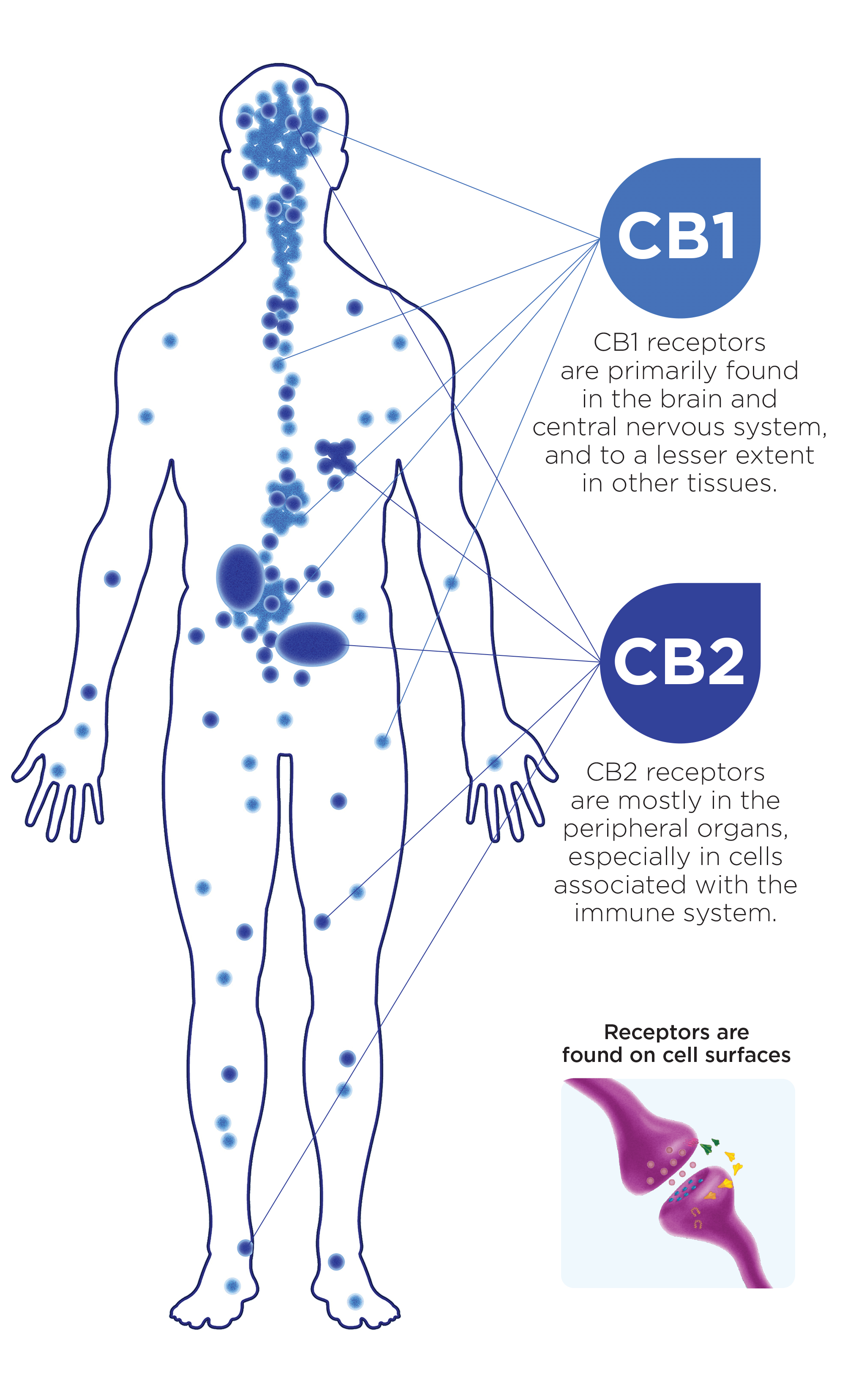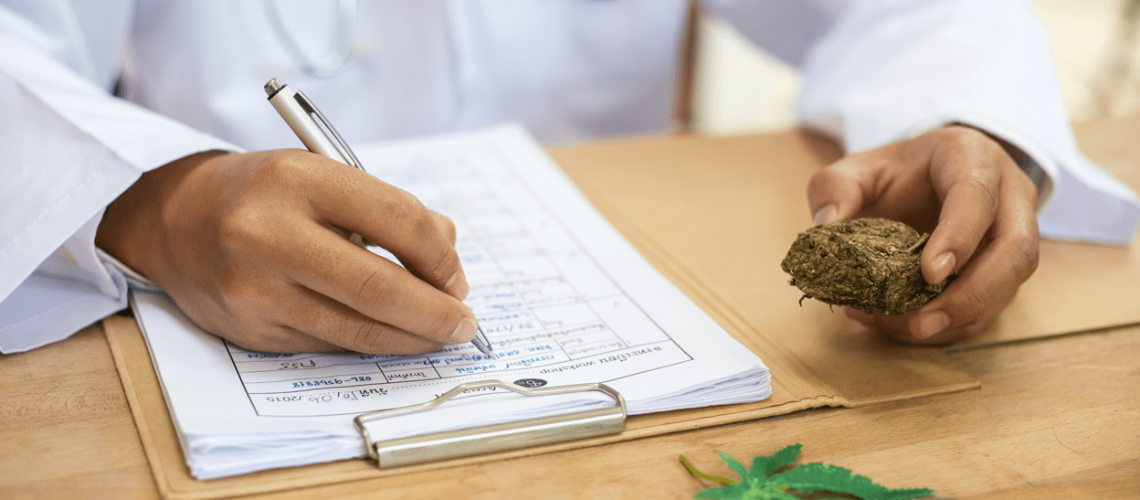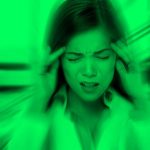A number of distinct compounds play a role in the cannabis effects. These are called Cannabinoids. Some increase appetite, some reduce inflammation, some even show promise for fighting cancer. Of these compounds, THC (tetrahydrocannabinol) and CBD (cannabidiol) are the most known. These cannabinoids impact our sense of well-being and state of mind.
We’ve learned that endocannabinoids play a role in regulating everything from appetite and sleep to the joyful bliss of a runner’s high. They do so by modifying the release of other neurotransmitters that have a more direct impact on mood, energy and anxiety.
Endocannabinoids help maintain homeostasis” (the brain’s baseline state) via what’s known as retrograde signaling (feedback loops that travel backward through a neural circuit to reset the system.) Their regulating activity at CB1 receptors influences both excitatory and inhibitory signaling in the brain.

CB1 receptors are distributed all over the body but mostly in high numbers in areas of the brain that appraise threats and manage our fear response. Binding of endocannabinoids appears to decrease the brain’s reactivity to threat — which helps explain why many people experience the cannabinoids as anxiety-relieving.
But with regular use of cannabis, your number of CB1 receptors decreases — that is, they are down-regulated. So although the compounds in cannabis can induce a feeling of calm and well-being by binding to CB1, they leave areas of the brain less sensitive to our own natural endocannabinoids. With cessation of cannabis use, CB1 receptors begin to recover their normal numbers within days.
Here’s where it gets interesting: THC demonstrates a bi-phasic dose effect. This means that at low doses it does one thing, and at higher doses it does the opposite. This is not really news to anyone who has ever tried marijuana, as it’s common knowledge that a little makes you mellow, a little more can give you anxiety. What’s surprising is how narrow the dose window between happy and anxious – especially for the new or infrequent user. A significant proportion of patients with new-onset panic attacks report cannabis as the trigger and worry that they’ve caused lasting damage. (The answer is no, but when your brain has an intense scare it tends to revisit the experience again and again, perhaps to assess the actual threat.)

Medicating with marijuana isn’t as simple as getting any kind of Marijuana — every strain has unique effects and different routes offer different effects. But it isn’t terribly complicated as long as you do your research and consult with your doctor and dispensary. Indica is high in CBD, which is known for its ability to decrease anxiety, while Sativa has THC, which can cause anxiety. So you’ll want to find an Indica or Indica dominant hybrid that has a high amount of CBD.
- Cannatonic: For the THC-sensitive, we recommend this high CBD strain. It typically has a CBD profile that sizes up to its THC content in a 1:1 ratio, which helps blunt the anxious edge that a lot of anxiety-sufferers experience with cannabis.
- Amnesia Haze: Has about 20 percent Sativa in it, meaning it doesn’t make you as tired as a pure Indica strain would. On the other hand, you may want to be extra careful when using Amnesia Haze, since the THC in Sativa can make you more anxious.
- Chocolate Chunk: Chocolate Chunk provides full-body relaxation and its another example of a pure Indica. Since it’s so powerful, you may only need a small amount to get results.
- Girl Scout Cookies: Hybrid with 60% Indica and 40% Sativa. Great for PTSD patients since it replaces some missing chemicals compounds in their brain that affect memory.
- Harlequin: Harlequin works similarly to Amnesia Haze, due to its small amount of THC. It relaxes users while keeping their minds clear and alert.
- Northern Lights: This full Indica gives you a powerful body relation will providing stress relief, in addition to helping you sleep and relieving pain.
University of Chicago recently published a study in which they looked at people who had used cannabis before but were not regular users. It showed that 7.5 mg of THC induced a mild elevation of mood and sense of well-being while 12.5 mg of THC made subjects anxious. So for the infrequent cannabis user, the line between relaxation and anxiety comes down to just a few milligrams. With regular use of cannabis, this window appears to widen: regular users have less anxiety and paranoia associated with THC ingestion than infrequent users.
CBD also appears to combat the anxiety-inducing impact of THC. Depending on what kinds of signaling activity is going on, what your own endocannabinoids are up to (factors controlled by your mood and physical settings), the arrival of THC and CBD on the scene has a widely varying impact.
Take home point is that for anxiety not always more is better. Trying to find that sweet spot in which Cannabis helps calm your anxiety without overshooting the mark with a dose that makes it worst will be your job since you know your brain better than anyone. And, if you did take too much, remember that no one has died from Cannabis and no one will, also know that CBD helps counteract that feeling and make sure you drink lots of water.
Related
-
How to Get a Medical Cannabis Card Near Me
Medical Marijuana has been available as a safe treatment in…
-
Juicing Cannabis: Relief Without The High
The act of juicing leafy greens like kale and spinach…
-
Top Medical Cannabis strains to treat pain
Cannabis reputation has changed considerably in the last several years. Both…




